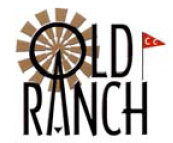Behind The Scenes August 25th 2010 (Page One)
We were minding our own business having a drink when it was announced that the Superintendent was having an open house.... We lept from the tables, found a gold cart, and careened through ther woods to see what it was all about... What an enjoyable evening!

Follow the foood
Did you know? - A professional who maintains a golf course or country club. Greenskeepers usually work under the direction of a golf course superintendent. Work includes mowing greens, fairways and tees, fertilizing, irrigation, scouting for pests and pesticide applications, pruning, and arranging the pins (flags) and tee markers for daily and tournament play.
Other non daily duties include all cultural requirements for maintain healthy turf such as aerating, topdressing, rolling and verticutting. The work does not have "rules" but is virtually dictated by the rules of golf established by the United States Golf Association.

The bosses office... Beware Ye Who Enter Here!
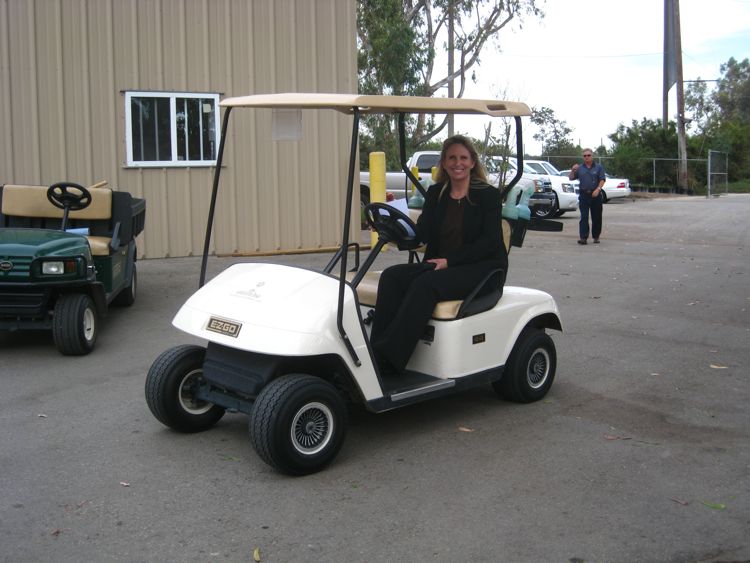
Lynn is geeting idea for a tour of the kitchen in the future

"Greetings ladies and gentlemen... You are about to be amazed!"

Did you know? - Greenskeepers measure the "speed" of golf greens with a stimpmeter. The Stimpmeter is used to compare greenspeed within a facility to ensure consistency. Stimpmeter readings should not be used to compare one facility to another-many factors including design, undulation and grass type affect green speed. The tool measures how fast a green allows the golf ball to travel. A greenskeeper can increase the speed of the green by mowing the grass shorter, mowing more than once in multiple directions, or by topdressing the green with a small amount of fine sand to alter the putting surface.

Linda is a Construction Inspector for the County and Sue was a Chief Engineer for Boeing...
These guys are in trouble!

Paul, Ken, and Jim

They need their own pump with all the vehicles required to maintain the course
Did you know? - The first gasoline pump was invented and sold by Sylvanus F. Bowser in Fort Wayne, Indiana on September 5, 1885.[2] This pump was not used for automobiles, as they had not been invented yet. It was instead used for some kerosene lamps and stoves. He later improved upon the pump by adding safety measures, and also by adding a hose to directly dispense fuel into automobiles. For a while, the term bowser was used to refer to a vertical gasoline pump. Although the term is not used anymore in the United States, it still is used sometimes in Australia and New Zealand.
Many early gasoline pumps had a calibrated glass cylinder on top. The desired quantity of fuel was pumped up into the cylinder as indicated by the calibration. Then the pumping was stopped and the gasoline was let out into the customers tank by gravity. When metering pumps came into use, a small glass globe with a turbine inside replaced the measuring cylinder but assured the customer that gasoline really was flowing into the tank. ~Wikipedia
James Found The Food!
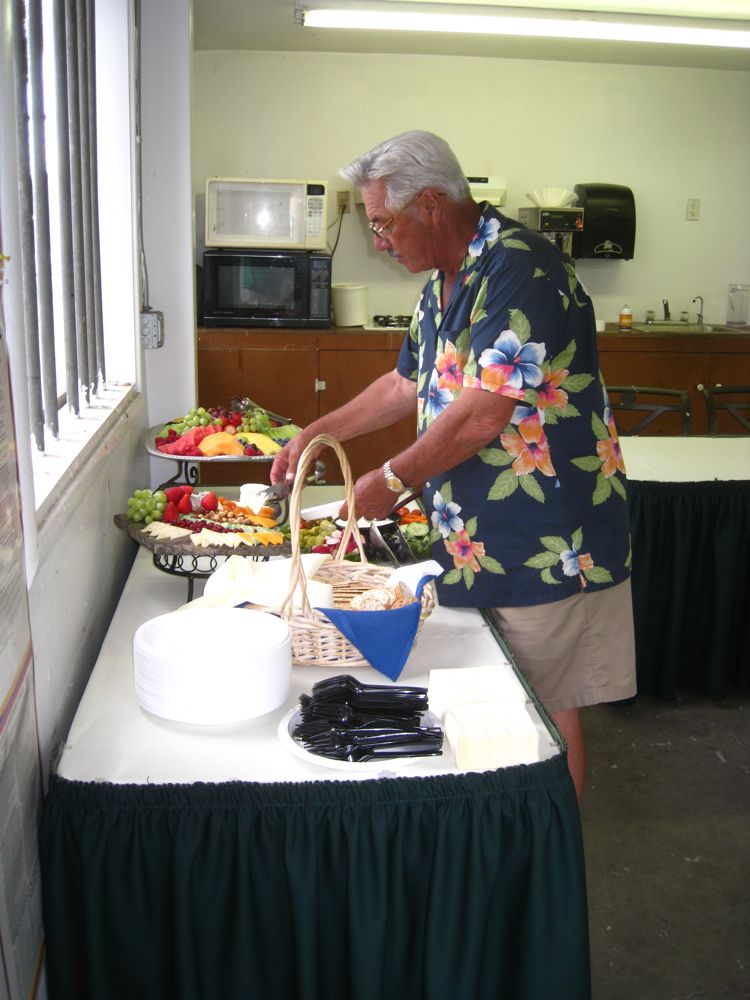
"Oh heck, I will just have a little of everything!"
Of Course, Bob Found The Drinks!

"I think I will have one f each also!"

The table is getting busy!

"What can I get you sir?"
The Tour Is About To Begin


They go to the same barber!
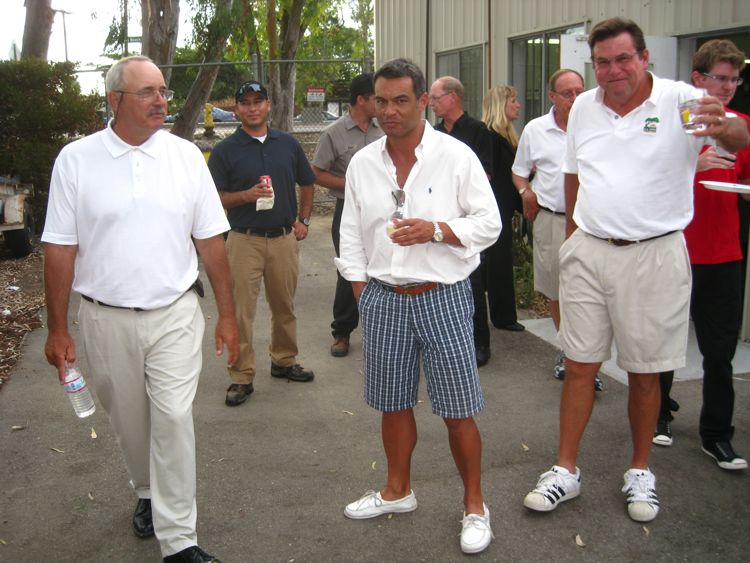
"Please follow me..."

"Communications is vital on this big a piece of property!"

Did you know? - A walkie-talkie, or handie talkie, (more formally known as a handheld transceiver) is a hand-held, portable, two-way radio transceiver. Its development during the Second World War has been variously credited to Donald L. Hings, radio engineer Alfred J. Gross, and engineering teams at Motorola.
The first radio receiver/transmitter to be widely nick-named "Walkie-Talkie" was the backpacked Motorola SCR-300, created by an engineering team in 1940 at the Galvin Manufacturing Company (fore-runner of Motorola).
Motorola also produced the hand-held AM SCR-536 radio during World War II, and it was called the "Handie-Talkie" (HT). The terms are often confused today, but the original walkie talkie referred to the back mounted model, while the handie talkie was the device which could be held entirely in the hand (but had vastly reduced performance).
Both devices ran on vacuum tubes and used high voltage dry cell batteries. (Handie-Talkie became a trademark of Motorola, Inc. on May 22, 1951. The application was filed with the U.S. Patent and Trademark Office, and the trademark registration number is 71560123.
In The Nerve Center
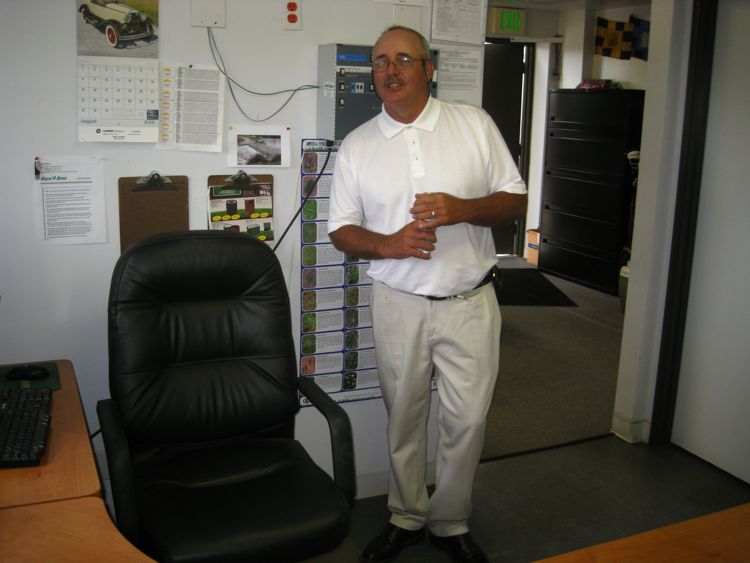
The sprinkler system controls 2,700 heads!
Did you know? - Rain Bird Corporation is a large privately held manufacturer and provider of irrigation products and services, based in Glendora, California. Rain Bird had its origins in 1932 when California citrus grower Orton Englehardt developed the first prototype of the impact sprinkler.
By 1933, his friend and neighbor Clement LaFetra was helping him make the sprinklers and urged him to patent the invention. Englehardt preferred farming, so in 1935 he sold the burgeoning business to LaFetra, whose descendants still operate the company.
The name Rain Bird was taken from the Native American legend of a bird that brought rain, in reference to the "bird-like" appearance of the impact sprinkler in action. Since its beginnings, Rain Bird has offered irrigation products for farms, golf courses.

All watering is controlled from here

They had a myriad of questions!

Must have been a humorous answer

The REAL workers! The guys who keep things going!

With this little device I can control the water sooooo... You better be nice to me or you could get wet!

Terror! Re-Boot!

"I wonder if he could trun on the water when it is so hot!"
Out Of My Office!
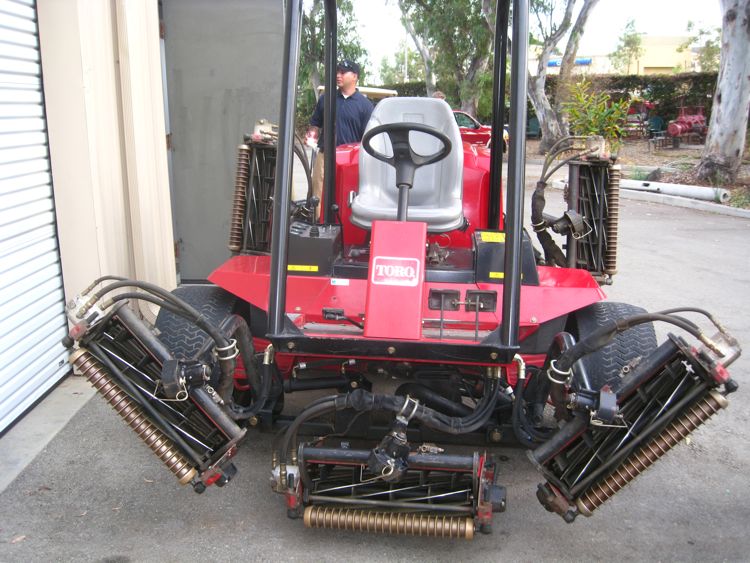
Quite a machine!
Did you know? - Based in Bloomington, Minnesota, The Toro Company (NYSE: TTC) is an American manufacturer of turf maintenance equipment (lawn mowers), snow removal equipment (snow blowers) and water-saving irrigation systems for golf courses, sports fields, public green spaces, commercial and residential lawns, and agricultural fields.
In 1986, Toro acquired the Wheel Horse Products Division of American Motors (AMC). Wheel Horse manufactured a wide range of lawn and garden tractors, as well as riding lawn mowers. The division was spun off from AMC as the automaker focused company strategy on vehicles. Lawn and garden tractors were then marketed under the Toro, Wheel Horse, as well as the Toro Wheel Horse names. Acquisitions continued with the purchase of Lawn-Boy in 1989, James Hardie Irrigation in 1996, Exmark Manufacturing in 1997, Hayter Ltd. in 2005, and Rain Master Irrigation Systems and Turf Guard Wireless Monitoring Technology in 2007.
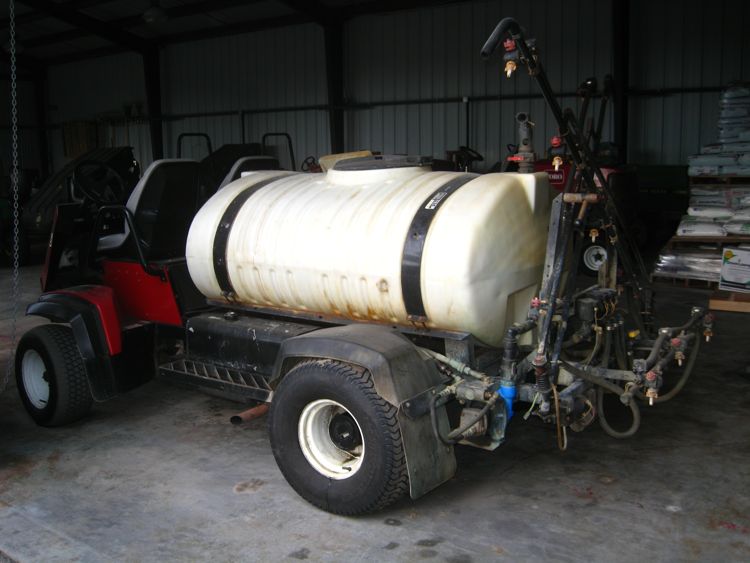
Keeping the fertilizer flowing!
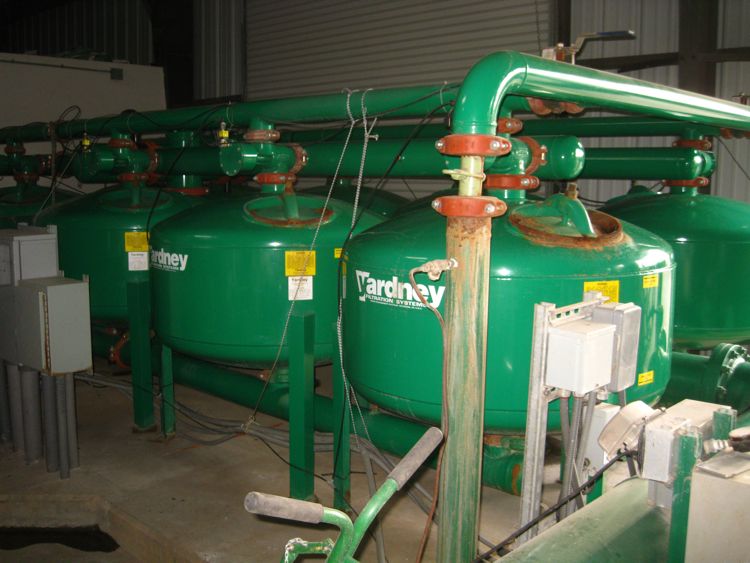
Water filtration is essential
Did you know? - All the Old Ranch lakes are connected and 90% of the water on the property comes from wells. They do NOT like t use "run-off" as the chemical content is unknown! Old Ranch is designated as a "Flood Control Area" and receives water from all over the area when it rains.
Old Ranch needs permission to let water in the floor control channels during the Summer only (April through October)! Want to make sure workers don't get wet. In the Winter, they can dump water anytime they need too!

Pumps and controller for the sprinkler systems. The small pump is 25 HP
Did you know? - The development of the steam engine provided a reason to compare the output of
horses with that of the engines that could replace them. In 1702, Thomas Savery wrote in The Miner's Friend:
"So that an engine which will raise as much water as two horses, working together at one time in such a work,
can do, and for which there must be constantly kept ten or twelve horses for doing the same. Then I say, such an
engine may be made large enough to do the work required in employing eight, ten, fifteen, or twenty horses to be
constantly maintained and kept for doing such a work…"
The idea was later used by James Watt to help market his
improved steam engine. He had previously agreed to take royalties of one third of the savings in coal from the
older Newcomen steam engines. This royalty scheme did not work with customers who did not have existing steam engines but used horses instead. Watt determined that a horse could turn a mill wheel 144 times in an hour (or 2.4 times a minute). The wheel was 12 feet in radius, therefore the horse travelled 2.4 × 2π × 12 feet in one minute. Watt judged that the horse could pull with a force of 180 pounds.
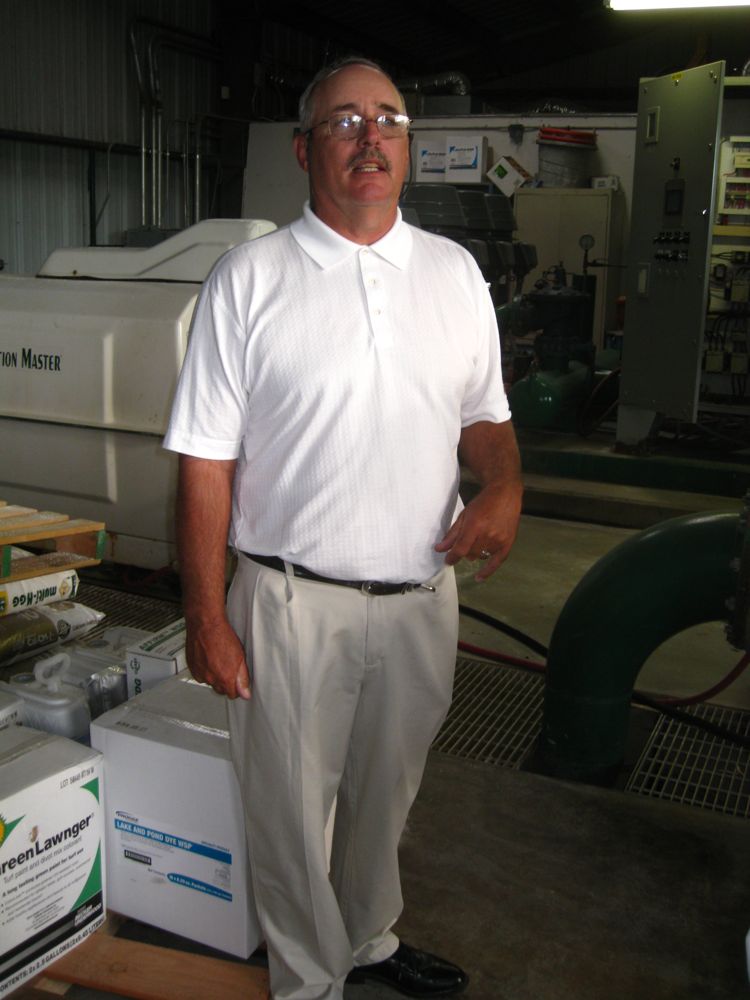
It gets pretty noisy when the pumps come on!

Each of the three 75 HP pumps can move 800 gallons per minute... With everything going we can move 2,800 gallons per minute

Everybody is learning something new
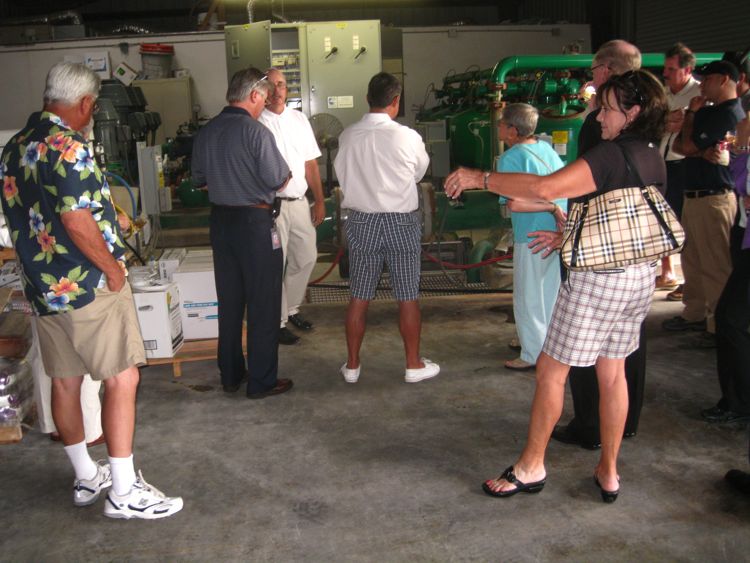
Bunny practices a new golf swing... I think?
Did you know? - An Impact sprinkler (sometimes incorrectly called an impulse sprinkler) is a type of Irrigation sprinkler. The original horizontal action impact drive sprinkler was invented by Los Angeles citrus farmer Orton Englehardt in 1933 and patented in 1935 (US Patent #1,997,901). Orton later sold it to Clem and Mary LaFetra who manufactured and marketed it under the brand name Rain Bird.

Fertilizer can be put into the water stream at the office!

Expensive bags of chemicals
Did you know? - Main content About Yara Yara International ASA is a global firm specializing in agricultural products and environmental protection agents. As the world’s largest supplier of mineral fertilizers, Yara helps provide food and renewable energy for a growing world population. Our products also help cleanse the air and eliminate toxic waste. The Oslo-based company has about 7,600 employees and annual revenues of nearly NOK 62 billion with operations in more than 50 countries.

Amazing stories
Did you know? - The fertilizer bags are about $50 each! The fertilizers are applied about every six months

The audience was captivated (or soused??)

Bob, Bunny and Linda

Bunny, Linda and Sue

The filters are backwashed every day and it takes about eight hours
Did you know? - Backwash is the backwards flow of air or water. In terms of water treatment, including water purification and sewage treatment, backwash refers to the reversal pumping of water, and sometimes intermittent with compressed air, through the process. Backwashing is a form of preventive maintenance to prevent further clogging of the filter medium. Backwashing in water treatment plants can be automated process, usually run by programmable logic controllers (PLCs). The backwash cycle is usually triggered when the differential pressure over the filter exceeds a set value

Now that is amazing!

He knows his stuff!

No James... Do not backwash you drink!


Let's move on!
Specialized Equipment

They do al the blade sharpening onsite

It costs as much as a luxury car!
Did you know? - Verticutting to remove excessive thatch, force the grass blades to stand upright, thin out excessive growth and speed up greens. Vertical mowing, or verticutting, describes using a machine equipped with blades that reach vertically into the turf canopy to cut through lateral stems and dislodge thatch. You can adjust the blade height of most units to control how deeply you cut into the turf and how much thatch you remove.
The shape and length of the blades, and the spacing between them, vary depending on the type of unit and its manufacturer. A vertical mower is a machine with solid-mounted blades on an axle. Dethatchers or power rakes, by contrast, have blades or wire tines connected to the axle with springs or as flails to allow some movement in response to striking a hard object. However, both are frequently used to dethatch turf.

Built in Australia

It takes a lot of capital spending to maintain the course

John Deere equipment everywhere
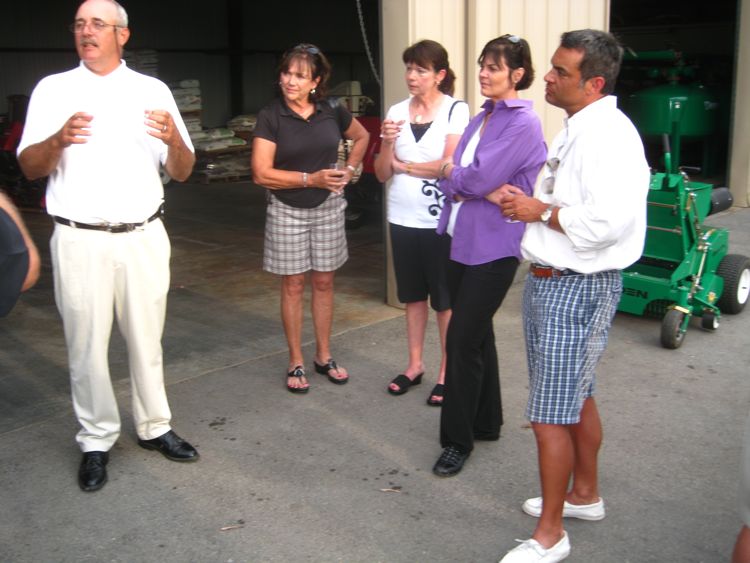

Bob explains the details and demonstrates why golfers shold ALWAYS wear socks
Did you know? - Socks have evolved over the centuries from the earliest models which were made from animal skins gathered up and tied around the ankles. In the 8th century BC, the Ancient Greeks wore socks from matted animal hair for warmth. The Romans also wrapped their feet with leather or woven fabrics. By the 5th century AD, socks called ‘puttees’ were worn by holy people in Europe to symbolise purity. By 1000 AD, socks became a symbol of wealth among the nobility. From the 16th century onwards, an ornamental design on the ankle or side of a sock has been called a clock.
The invention of a knitting machine in 1589 meant that socks could be knitted six times faster than by hand. Nonetheless, knitting machines and hand knitters worked side by side until 1800

"This really is interesting!"

James wants to go for a ride!

"No dear... You stay away from the machines!"

"Just a teensie weensie bit more... Plueeeeeze"

"The Gringo;s believe anything we say!"
Did you know? - "Gringo" has been in use in the English language since the 19th century. According to the Oxford English Dictionary, the first recorded use of the term in an English source is in John W. Audubon's Western Journal of 1849; Audubon recalls that he and his associates were derided and called "Gringoes" while passing through the town of Cerro Gordo, Veracruz.
